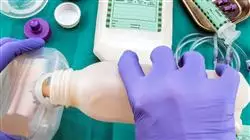University certificate
The world's largest faculty of medicine”
Introduction to the Program
Thanks to this 100% online Advanced master’s degree, you will acquire the necessary tools to adequately evaluate the nutritional status of your patients, design personalized dietary plans and monitor their progress”

Clinical Nutrition is fundamental in medical practice, recognizing its ability to positively influence the health and well-being of patients By integrating knowledge about the relationship between food and health, medical professionals can design personalized interventions that address specific medical conditions, promoting recovery, preventing disease and improving quality of life.
In this context, TECH has developed this comprehensive Advanced master’s degree, which will cover a variety of topics fundamental to understanding the interaction between food and human health Therefore, physicians will analyze in depth the principles of Nutrition, from the biochemistry of nutrients to specific dietary recommendations for various medical conditions In addition, patients' nutritional status will be assessed and personalized dietary plans will be designed In fact, graduates will use nutritional assessment tools and methods, and interpret the results to determine individual dietary needs This includes the application of specific nutritional strategies to address medical conditions such as Diabetes, Obesity, Cardiovascular Disease and many others.
Finally, professionals will be prepared to work collaboratively within multidisciplinary health care teams In this way, effective communication with other healthcare professionals will be emphasized, ensuring a comprehensive approach to patient treatment In addition, students will be equipped with the skills necessary to provide quality care and lead health promotion and disease prevention initiatives.
This Advanced master’s degree, available online, will offer students the flexibility to participate from anywhere and at their convenience It will also rely on the innovative Relearning methodology, which is pioneering in TECH and provides a unique learning experience In addition, students will have access to exclusive and complementary Masterclasses, given by experts in Clinical Nutrition, Genomic Nutrition and Intestinal Microbiota.
You will enjoy an exclusive set of additional Masterclasses, led by internationally renowned experts Access this specialized content to enrich your professional practice now!”
This Advanced master’s degree in Clinical Nutrition for Medicine contains the most complete and up-to-date scientific program on the market The most important features include:
- The development of case studies presented by experts in Clinical Nutrition in Medicine
- The graphic, schematic, and practical contents with which they are created, provide scientific and practical information on the disciplines that are essential for professional practice
- Practical exercises where the self-assessment process can be carried out to improve learning
- Special emphasis on innovative methodologies in Clinical Nutrition in Medicine
- Theoretical lessons, questions to the expert, debate forums on controversial topics, and individual reflection assignments
- The availability of access to the contents from any fixed or portable device with an Internet connection
You will implement Clinical Nutrition as a fundamental pillar in the comprehensive care of your patients, promoting healthy eating habits and preventive medical care”
It includes in its teaching staff professionals belonging to the field of Clinical Nutrition, who pour into this program the experience of their work, as well as recognized specialists from reference societies and prestigious universities.
Its multimedia content, elaborated with the latest educational technology, will enable contextual learning, ie, a simulated environment that will provide an immersive study programmed to specialize in real-life situations.
This program is designed around Problem-Based Learning, whereby the student must try to solve the different professional practice situations that arise throughout the program For this purpose, the professional will be assisted by an innovative interactive video system created by renowned and experienced experts.
You will develop leadership and management skills, necessary to lead multidisciplinary teams and promote the integration of Nutrition in medical practice"

Bet on TECH! You will delve into how different nutrients impact physiology and organ function, as well as the scientific basis behind therapeutic diets"
Why study at TECH?
TECH is the world’s largest online university. With an impressive catalog of more than 14,000 university programs available in 11 languages, it is positioned as a leader in employability, with a 99% job placement rate. In addition, it relies on an enormous faculty of more than 6,000 professors of the highest international renown.

Study at the world's largest online university and guarantee your professional success. The future starts at TECH”
The world’s best online university according to FORBES
The prestigious Forbes magazine, specialized in business and finance, has highlighted TECH as “the world's best online university” This is what they have recently stated in an article in their digital edition in which they echo the success story of this institution, “thanks to the academic offer it provides, the selection of its teaching staff, and an innovative learning method aimed at educating the professionals of the future”
A revolutionary study method, a cutting-edge faculty and a practical focus: the key to TECH's success.
The most complete study plans on the university scene
TECH offers the most complete study plans on the university scene, with syllabuses that cover fundamental concepts and, at the same time, the main scientific advances in their specific scientific areas. In addition, these programs are continuously being updated to guarantee students the academic vanguard and the most in-demand professional skills. In this way, the university's qualifications provide its graduates with a significant advantage to propel their careers to success.
TECH offers the most comprehensive and intensive study plans on the current university scene.
A world-class teaching staff
TECH's teaching staff is made up of more than 6,000 professors with the highest international recognition. Professors, researchers and top executives of multinational companies, including Isaiah Covington, performance coach of the Boston Celtics; Magda Romanska, principal investigator at Harvard MetaLAB; Ignacio Wistumba, chairman of the department of translational molecular pathology at MD Anderson Cancer Center; and D.W. Pine, creative director of TIME magazine, among others.
Internationally renowned experts, specialized in different branches of Health, Technology, Communication and Business, form part of the TECH faculty.
A unique learning method
TECH is the first university to use Relearning in all its programs. It is the best online learning methodology, accredited with international teaching quality certifications, provided by prestigious educational agencies. In addition, this disruptive educational model is complemented with the “Case Method”, thereby setting up a unique online teaching strategy. Innovative teaching resources are also implemented, including detailed videos, infographics and interactive summaries.
TECH combines Relearning and the Case Method in all its university programs to guarantee excellent theoretical and practical learning, studying whenever and wherever you want.
The world's largest online university
TECH is the world’s largest online university. We are the largest educational institution, with the best and widest online educational catalog, one hundred percent online and covering the vast majority of areas of knowledge. We offer a large selection of our own degrees and accredited online undergraduate and postgraduate degrees. In total, more than 14,000 university degrees, in eleven different languages, make us the largest educational largest in the world.
TECH has the world's most extensive catalog of academic and official programs, available in more than 11 languages.
Google Premier Partner
The American technology giant has awarded TECH the Google Google Premier Partner badge. This award, which is only available to 3% of the world's companies, highlights the efficient, flexible and tailored experience that this university provides to students. The recognition as a Google Premier Partner not only accredits the maximum rigor, performance and investment in TECH's digital infrastructures, but also places this university as one of the world's leading technology companies.
Google has positioned TECH in the top 3% of the world's most important technology companies by awarding it its Google Premier Partner badge.
The official online university of the NBA
TECH is the official online university of the NBA. Thanks to our agreement with the biggest league in basketball, we offer our students exclusive university programs, as well as a wide variety of educational resources focused on the business of the league and other areas of the sports industry. Each program is made up of a uniquely designed syllabus and features exceptional guest hosts: professionals with a distinguished sports background who will offer their expertise on the most relevant topics.
TECH has been selected by the NBA, the world's top basketball league, as its official online university.
The top-rated university by its students
Students have positioned TECH as the world's top-rated university on the main review websites, with a highest rating of 4.9 out of 5, obtained from more than 1,000 reviews. These results consolidate TECH as the benchmark university institution at an international level, reflecting the excellence and positive impact of its educational model.” reflecting the excellence and positive impact of its educational model.”
TECH is the world’s top-rated university by its students.
Leaders in employability
TECH has managed to become the leading university in employability. 99% of its students obtain jobs in the academic field they have studied, within one year of completing any of the university's programs. A similar number achieve immediate career enhancement. All this thanks to a study methodology that bases its effectiveness on the acquisition of practical skills, which are absolutely necessary for professional development.
99% of TECH graduates find a job within a year of completing their studies.
Advanced Master's Degree in Clinical Nutrition for Medicine
One of the indispensable factors in maintaining a good state of health is nutrition. In fact, nutrition has a significant influence on the adherence to treatments in patients suffering from any type of pathology, from the evolution of their condition to rehabilitation times and the probability of readmission. For this reason, nutritional management is an area that requires highly qualified professionals, especially in the latest advances it has developed. In TECH Global University we developed the Advanced Master's Degree in Clinical Nutrition for Medicine, a program with which you can develop your skills to the maximum in the field with the most complete and up-to-date content and the support of experts in the area that will guide your process.
Become a specialist in Clinical Nutrition for Medicine
Through our program, presented in a 100% online format, you will be able to access the most relevant topics and procedures in the field of clinical nutrition in order to acquire the necessary knowledge and skills to implement them in your daily practice. In this way, you will review the basics of a balanced diet in order to assess the condition of your patients, and you will calculate the nutritional requirements according to their particular situation. You will implement the trends and methods of intervention in the management of simple and complex cases, such as those requiring nutritional support. You will learn about dietary design and planning according to the different pathologies, and you will consider food safety as a principle of all professional performance. Get your qualification at the largest School of Medicine and continue advancing in your professional career.







